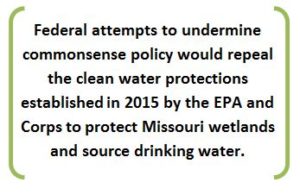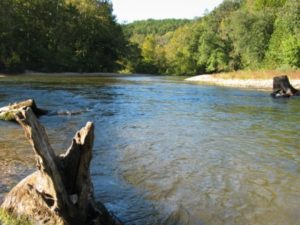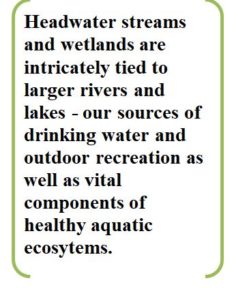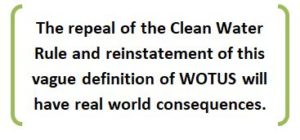by Alicia Claire Lloyd
Take action by signing the 1Mississippi’s “Repel the Repeal” petition here and support the Clean Water Rule!
Federal attempts to undermine commonsense policy would repeal the clean water protections established in 2015 by the EPA and Corps to protect Missouri wetlands and source drinking water. Our own Missouri senator, Claire McCaskill supports rescinding the rule. Call or write Senator McCaskill to let her know, now more than ever, we need her to put the public above special interests and support the Clean Water Rule and EPA in its work to protect our waters.
The Trump Administration has started the process to repeal the Clean Water Protection Rule, often called “WOTUS” in reference to its attempt to clarify what constitutes a “water of the U.S.” under the Clean Water Act (CWA). The rule, finalized by the Army Corps of Engineers and the Environmental Protection Agency (EPA) in 2015 after considering feedback from over 400 public meetings and more than 1,000,000 public comment letters, has been targeted for repeal by polluters. As part of the Administration’s attempts to undermine environmental protections and the EPA, the agencies have proposed to rescind the rule.
By clearly spelling out what constitutes “Waters of the United States” under the Clean Water Act, the rule provides clarity, efficiency, and cleaner water by better defining which rivers, streams, lakes, and wetlands the Act protects while maintaining existing agricultural exemptions. The rule provides certainty regarding who is regulated for pollution controls and who is not. It is based on a vast body of scientific literature that recognizes the vital connections between smaller streams and wetlands and downstream waters. It also presents the opportunity to tell the agencies to fully protect waters that are often wrongly written off as “isolated,” but that science shows provide important functions.
The president took actions to stall the implementation of EPA and the Corps’ Clean Water Rule as soon as he took office. Trump signed an Executive Order at the end of January to initiate the repeal of the rule. The repeal would reenact regulations on the books prior to clean water rule – date to mid 80s. These regulations were largely thrown into doubt by the Supreme Court as they did not clearly define what constitutes a Water of the U.S. and therefore, what waters should be covered by the Clean Water Act.
The President, EPA Administrator, Scott Pruitt, and others’ agenda seeks to take off the books the clarity established by Clean Water Rule and put back in place the mess in place in the 1980s. They refer to this act as “return to the status quo”, but this is largely smoke and mirrors. They seek to get rid of the Clean Water Rule for a couple of major reasons – to avoid the possibility that the litigation regarding the rule may play out to reveal it was supported by logic and science as well as to avoid the possibility that the rule could be implemented and prove not as devastating as opponents purport.
The rule repeal would happen in two steps. The first – would rescind the proposed clarification of the “Waters of the US” definition as applied to Clean Water Act implementation. After this change is published in the Federal Registrar, a short 30 day public comment period would follow.
A second step would replace the rule with rules based on opinion in one of the Supreme Court ruling written by Justice Scalia, yet opposed by the remainder of the judges. The repeal of the Clean Water Rule and reinstatement of this vague definition of WOTUS will have real world consequences. Scalia’s opinion states that waters must be “relatively permanent” which would exclude all intermittent and ephemeral streams. It also states that waters must have a “continuous surface connection” to other waters of the U.S. The way this is interpreted could potentially exclude many, many wetlands. Isolated wetlands account for about 20% of wetlands in the lower 48 states.
Many wetlands are separated from rivers by man-made levees. Rules have historically protected these wetlands, still considering them “adjacent” wetlands. It is unclear at this point if the Scalia interpretation would continue to protect those waters.
Within the Congressional Energy and Water appropriations bill, a provision states that in repealing the Clean Water Rule, the Trump Administration can effectively ignore any law. What that means is, were it to become law, the Administration could ignore public comment all together without any requirement to explain their actions. They could adopt a completely arbitrary rule despite the Administrative Procedures Act’s prohibition.
This is a significant assault on our water protections and we need to oppose this.
The federal economic impact analysis currently posted on EPA’s website associated with the new rule does not include the lost public benefits of wetlands and other natural resources if the new rule is adopted. Although those benefits of wetlands will be foregone, they are deemed too difficult to quantify so they are not included as benefits. When economic costs of lost natural resources and ecosystem services are not quantified, their value is effectively deemed zero. We know this is not the case.
Let EPA and Congress know you oppose the repeal of the Clean Water Rule here.
As a Mississippi River Network Policy Committee member, the Missouri Coalition for the Environment will be submitting public comments on the proposed rollback of the Clean Water Rule and its replacement when it is published on the Federal Register. Stay tuned to MCE, 1Mississippi, and the Natural Resource Defense Council for updates on the attacks on the Clean Water Rule.



